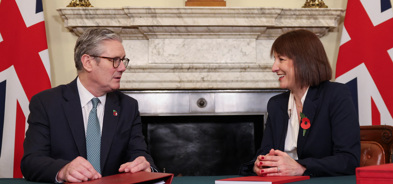January Market Pulse – are equities disconnected from reality?
Despite the slowdown in economic growth in 2019 and disturbing global events since the beginning of this year, equity markets have been remarkably robust
The value of investments can fall as well as rise and that you may not get back the amount you originally invested.
Nothing in these briefings is intended to constitute advice or a recommendation and you should not take any investment decision based on their content.
Any opinions expressed may change or have already changed.
Written by Chris Godding
Published on 29 Jan 20206 minute read

Since our last publication of the Pulse in December, the US Embassy in Iraq has been attacked, Qasem Soleimani assassinated, a passenger jet shot down by the IRGC, fires have devastated parts of Australia and the deadly Coronavirus has emerged in China, yet equity markets have held up remarkably well.
This disconnect of equities from the real world was a source of torment for investors throughout 2019 and it appears set to continue.
During 2019, company earnings declined by just under 8% and emerging market earnings by close to 15%. MSCI UK earnings dropped by 8.6% and in the US, where a fiscal sugar rush helped to boost activity, corporate earnings still fell by over 5% on average. In the same year, the MSCI World Index rose 26.24% in local currency terms.
One of the principal reasons behind this disconnect was the broad easing of monetary conditions as it became clear during the latter part of last year that the Federal Reserve would, until further notice, not try to pre-empt inflation. Taking the pre-emptive rate rise off the table removed a major external risk for equity investors. It also suggests that if inflation does gather momentum, the reactive Fed and the policy lag will create its own set of new problems. If the current relative economic resonance, or stability, is disturbed by inflation, the risk of a return of boom and bust are higher. The corrective action is exponentially more difficult to get right and analogous to driving a car using the rear view mirror.
The slowdown in investment and trade last year meant that the change in interest rate policy at the Fed was essential to stabilising growth. The result was an improvement in investor sentiment that drove P/Es higher through 2019. The phase 1 trade deal between the US and China last December provided a fitting finale to equities. The performance of markets in 2019 reminds us, once again, that in the short term, the change in the market multiple or P/E is frequently the dominant driver of returns rather than earnings.
In 2020, we expect the global monetary accommodation to continue to be a tailwind at least until the fourth quarter but expect that incremental equity appreciation will be more dependent on actual earnings growth as opposed to further P/E expansion.
Since Fed policy remains one of the most significant levers in financial markets, the key questions for investors now are whether the stimulus in the US will achieve the inflation desired and what is the potential for overshoot.
For the moment, with a projected US deficit in excess of US $900 billion and total debt at 105% of GDP, inflation remains an aspiration. However, labour shortages are becoming a problem, wages are rising and any election driven fiscal boost may tip the scales enough for the Fed to move. In our view, the structural deflationary forces of technology and demographics remain quite powerful and will help keep inflation in check, at least until later in 2020 or even 2021. However, markets and investors are notoriously bad at forecasting inflation and it remains a key tail risk for equities via higher interest rates and lower valuation multiples.
Ask any monetarist and the outlook for earnings should be good given the stimulus and, as you would expect, the consensus of analyst agrees with a 10% rise in earnings on average across the MSCI forecast for 2020. These estimates suggest an earnings yield of 6% for global equities compared to 1.6% on a US ten year Treasury bond or 0.53% on a ten year UK gilt. The long run average is around 3.5%, which implies room for further significant equity appreciation at current bond yields. The small caveat is that the accuracy of the analyst estimates is not particularly good, which is of no surprise given the variables involved. History suggests that earnings estimates at the start of the year are cut by 50% – analysts tend to be too optimistic – which would reduce 2020 earnings growth to around 5%. However, even assuming the lower 4.5% growth would leave the earnings yield at 5.7%, which is a comfortable premium of 4% over Treasuries.
If sustained over ten years, that 4% excess return would compound to a total return of 48% and we would only normally start to get concerned if it went below 3%, either via US ten year bond yields rising above 2.5%, or a recession. Both of which appear unlikely.
The Coronavirus could challenge this rather optimistic view and will clearly impact the current fragile economic recovery. Coming during Chinese New Year is a mixed blessing with most factories closed for the holiday but domestic consumption in China and the region will undoubtedly be hit quite hard. External and transitory shocks are normally good buying opportunities but, on this occasion, short term investor sentiment is already quite positive and patience for some exuberance to be flushed out may be warranted.
Investor sentiment is particularly enthused in the technology sector and continues to favour growth over value. While the global aggregate of the MSCI technology sector trailing 12 month earnings multiple is a ‘reasonable’ 11x, the S&P Technology sector in the US is trading at 60x (average 38x) and a hefty 23x forward earnings. Technology is the best performing sector by far over the past 12 months, returning over 43% while the energy sector is the worst at 3.3%.
Investors are clearly expressing the view that tech is the future and oil is a stranded asset of the past. They also appear to believe that we are in a world of low interest rates, low cyclical growth and structural change. While we don’t expect market leadership to change until the end of this market cycle, it is worth noting that the risk premium investors are being offered in the US tech sector is now -1.5% (on forward estimates!) and paying to take risk rarely works out well in the long run so caveat emptor.
In the UK, there appears to be a significant post-election bounce flowing through the economy. This was recently reflected in a bounce in the sentiment indicators in both services and manufacturing. Anecdotal evidence, including client activity at Tilney, the property market and elsewhere suggests the release of a substantial pent up demand and we, like the Bank of England will look to see if it is sustainable. Our pre-election forecast of a healthy Conservative majority (we predicted 84 seats) was met with natural scepticism but it is good to see the relief rally in stocks being repeated in the real economy. However, given low core inflation and the structural headwinds facing the UK as it prepares to leave the EU there seems to be little reason why the Bank of England should not cut rates and, like the Fed, err on the side of too much stimulus rather than too little. Central banks are very well trained in slowing an economy and have plenty of policy tools to do so if required. The currency is likely to weaken if they do cut rates and also help move core inflation back toward the 2% target.
The US /Sino trade dispute had a material negative impact on investment and trade volumes during 2019. The Fed, the ECB and the PBOC have sown the seeds of stimulus and we were beginning to see a reaction and recovery. However, trade is the truncheon of the Trump administration and there are risks of a further reversal of globalisation as the focus now moves toward Europe.
The Coronavirus could also not have come at a worse time in terms of stalling momentum and could materially challenge the earnings growth assumptions for this year depending on the duration of the problem. It is a dynamic situation and it is too early to know the global implications and how the UK will be impacted. The good news in that investors are already bearish about the UK and underweight.
Get insights and events via email
Receive the latest updates straight to your inbox.
You may also like…


Market news
2024 Autumn Budget Overview: The key announcements from Chancellor Rachel Reeves




